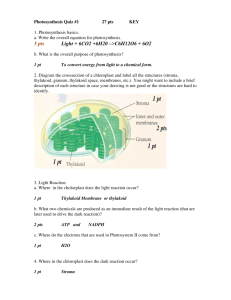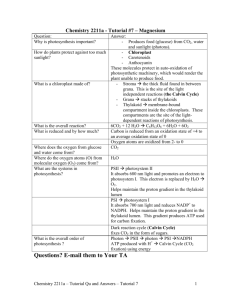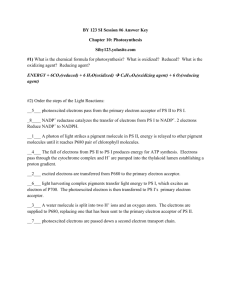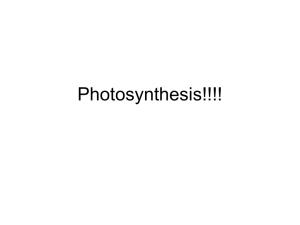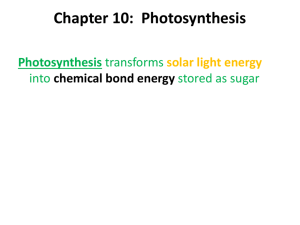Answers
advertisement
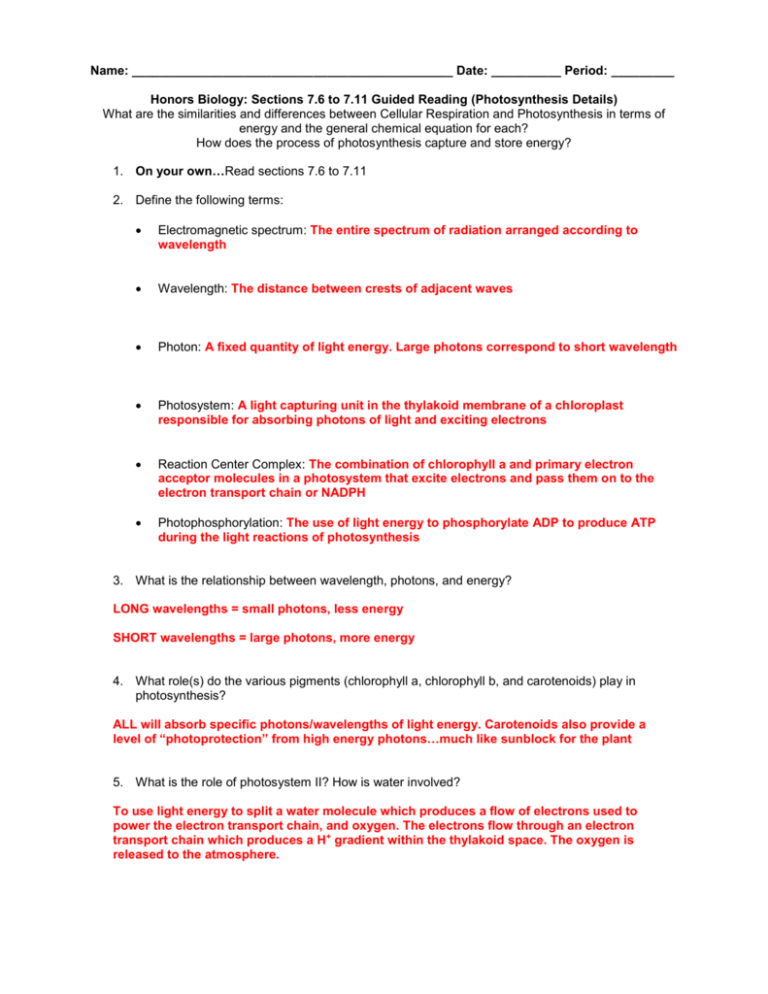
Name: ______________________________________________ Date: __________ Period: _________ Honors Biology: Sections 7.6 to 7.11 Guided Reading (Photosynthesis Details) What are the similarities and differences between Cellular Respiration and Photosynthesis in terms of energy and the general chemical equation for each? How does the process of photosynthesis capture and store energy? 1. On your own…Read sections 7.6 to 7.11 2. Define the following terms: Electromagnetic spectrum: The entire spectrum of radiation arranged according to wavelength Wavelength: The distance between crests of adjacent waves Photon: A fixed quantity of light energy. Large photons correspond to short wavelength Photosystem: A light capturing unit in the thylakoid membrane of a chloroplast responsible for absorbing photons of light and exciting electrons Reaction Center Complex: The combination of chlorophyll a and primary electron acceptor molecules in a photosystem that excite electrons and pass them on to the electron transport chain or NADPH Photophosphorylation: The use of light energy to phosphorylate ADP to produce ATP during the light reactions of photosynthesis 3. What is the relationship between wavelength, photons, and energy? LONG wavelengths = small photons, less energy SHORT wavelengths = large photons, more energy 4. What role(s) do the various pigments (chlorophyll a, chlorophyll b, and carotenoids) play in photosynthesis? ALL will absorb specific photons/wavelengths of light energy. Carotenoids also provide a level of “photoprotection” from high energy photons…much like sunblock for the plant 5. What is the role of photosystem II? How is water involved? To use light energy to split a water molecule which produces a flow of electrons used to power the electron transport chain, and oxygen. The electrons flow through an electron transport chain which produces a H+ gradient within the thylakoid space. The oxygen is released to the atmosphere. 6. What is the role of photosystem I? How is NADPH involved? To further boost or excite electrons coming out of the ETC. These excited electrons are picked up by NADPH and are used as potential energy to build G3P in the Calvin Cycle. 7. What is the purpose of the electron transport chain between PSII and PSI? To produce a H+ gradient within the thylakoid space of the chloroplast. This gradient provides the energy used to phosphorylate ADP to ATP in the process called photophosphorylation. 8. Compare and contrast photophosphorylation (during photosynthesis) with oxidative phosphorylation (during cellular respiration): Same idea…different source of energy input. Both processes add a phosphate to ADP to create ATP (an endergonic process) and both use ATP synthase as the enzyme that does the phosphorylating. The energy required to do this comes from the potential energy stored in a H+ gradient (either in the inner membrane space of the mitochondria or the thylakoid space of the chloroplast) In both cases the H+ is built by a flow of electrons. These electrons come from using light to split water (photo) vs. stripping them from carbon fragments that were originally part of glucose (in Citric Acid Cycle) 9. Describe the Calvin Cycle. What is Rubisco? A cycle of carbon containing intermediate molecules to which CO 2 is “fixed” during the second stage of photosynthesis. The ultimate product is Glyceraldehyde 3-phosphate (G3P) used to build glucose and other organic molecules. Rubisco is an enzyme, Ribulose bisphosphate carboxylase, that catalyzes the carbon fixing step of the Calvin Cycle. 10. The actual final product of the Calvin Cycle is…? So where does glucose come from? G3P (Glyceraldehyde 3-phosphate). Glucose (and other molecules) are then synthesized from G3P.







